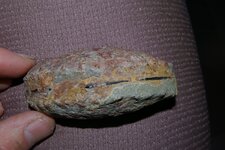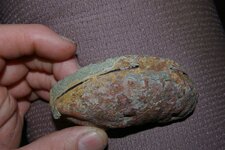kenstein
Hero Member
- Sep 28, 2012
- 574
- 618
- Detector(s) used
- Ace 250 , Pro pointer, AT Pro
- Primary Interest:
- Other
Follow along with the video below to see how to install our site as a web app on your home screen.
Note: This feature may not be available in some browsers.
Thanks Harry. Fossils from that "RED ZONE" are often of this same material. Could an ammonite have that black streak through the center? I'm just asking, because I haven't a clue. Thanks again for sharing your knowledge; I always value your remarks.....KenThe last image appears to be of a chunk of ammonite. Looks like a gemmy red replacement material -- carnelian, maybe?
Thanks Las Vegas Bob. These were not found together, but in the same section of the river. There is a thin red layer that shows up different times in different places. The Paleontology Society guide book just calls it the "The Red Zone", and fossils from it often have that look. Don't know what the black line through the center is....
I bet that piece you found looks awesome. Do you still have it?
Thanks Harry. Fossils from that "RED ZONE" are often of this same material. Could an ammonite have that black streak through the center? I'm just asking, because I haven't a clue. Thanks again for sharing your knowledge; I always value your remarks.....Ken

 Could this be the siphuncle that you referred to? Thanks again, and I'll leave you alone after this.
Could this be the siphuncle that you referred to? Thanks again, and I'll leave you alone after this.Thank you Harry for that info and the illustration. I know that you're dead-on correct about this being from an ammonite; not doubting that, but still curious about the black streak. Here is hopefully a better pic.View attachment 1144579View attachment 1144580 Could this be the siphuncle that you referred to? Thanks again, and I'll leave you alone after this.